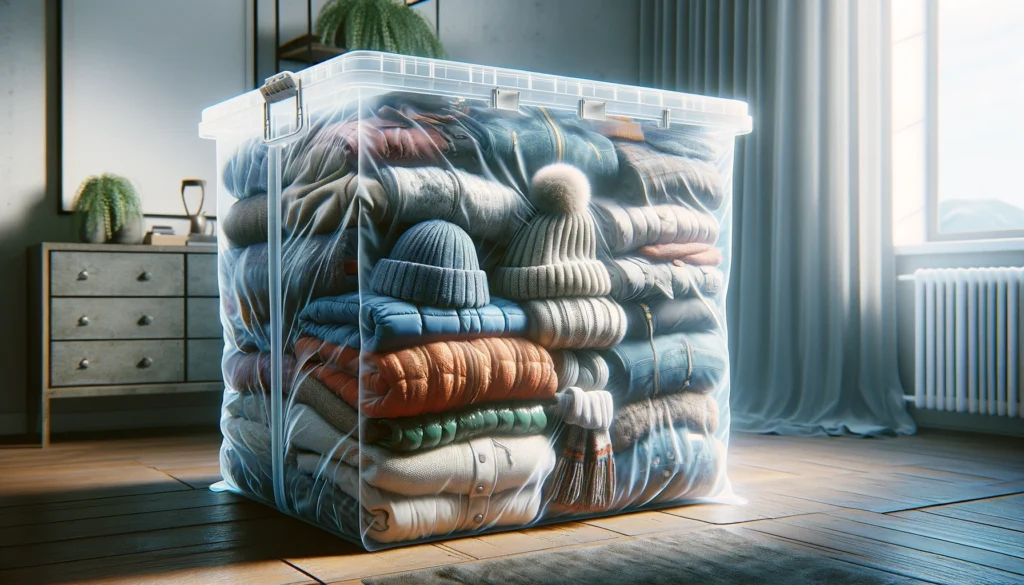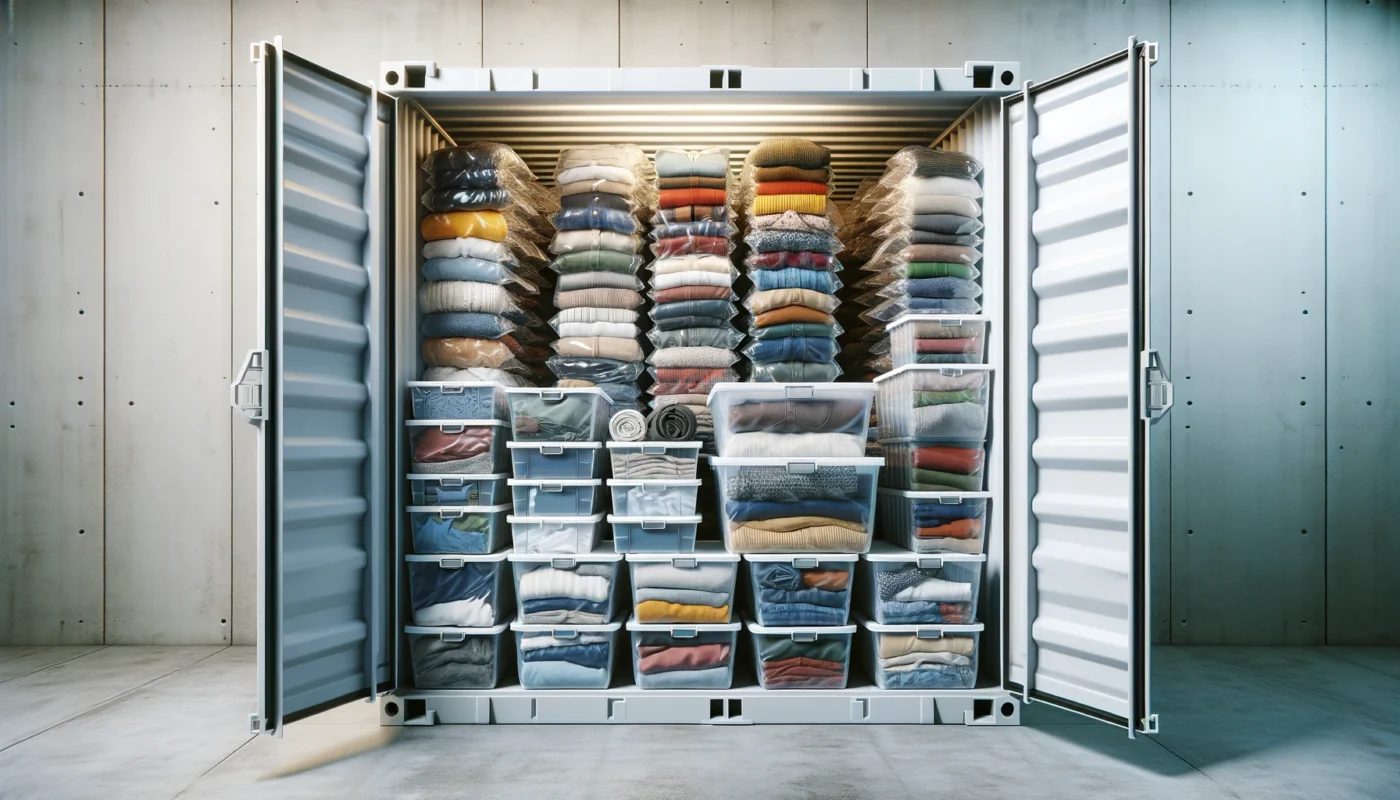There are many possible reasons why you might need advice on the best way to store clothes, whether it’s the fast nature of clothing fashion, the changing seasons in the UK or a temporary need for space during a house move. Whatever your motivation for storing clothing, our ‘How to Store Clothes’ guide is on hand to help you through the process with expert tips from an experienced voice in storage.
We will take you through the most popular and most effective methods to store clothes long term, as well as offering top tips on seasonal clothing storage and storing clothes in self storage units.
First, let’s discuss the materials you should be storing clothes in, before the location.

How to Store Clothes in Bags
Storing clothes in bags is a common option, but you should only do this if you are using vacuum sealed bags. If you simply store clothes in an old plastic bag, your clothes can become mouldy due to the moisture and heat that can be trapped inside a plastic bag.
Vacuum packing takes away this issue. They are readily available online and in home stores and are very easy to use. Simply fold your clothes as you desire inside the bag and attach a vacuum cleaner or vacuum pump to the designated slot to remove all the air inside.
This method of vacuum sealing your clothes in storage ensures your clothes will stay fresh over a long period of time and also saves a lot of space by reducing the bags down to the bare minimum size of your clothing. This is especially helpful if you’re storing large or thick clothing items.
The only drawback of vacuum sealing your clothes is that over a long period of time the fabrics may become damaged due to the extreme compression. It’s best to keep any delicate items elsewhere.
You can also purchase specific garment bags that do not use vacuum sealing. These are often rounded rectangles in shape, allowing for easy folding. These zip-sealed bags are a great option for short and medium term clothes storing but keep them in a cool and dry space.
How to Store Clothes in Cardboard Boxes
It may seem an obvious choice to store your clothes in a cardboard box, but there are significant drawbacks. One of these issues is that cardboard is very susceptible to mould if stored in a moisture-laden environment, which can then transfer onto your stored clothes.
Another disadvantage of cardboard boxes as clothing storage is vermin. It’s really easy for even a little mouse to gnaw through the cardboard and then into your clothing. Rodents may even decide a warm cardboard box full of your clothes is a nice place to set up a home and expand their family.
Despite these issues, there are ways to store clothes in heavy duty cardboard boxes effectively. After folding your clothes into heavy duty boxes and securing the boxes tightly using packing tape, pack the boxes above the ground, potentially using pallets or shelving. This should be in a cool, dry and dark room or storage facility away from windows and doors that ideally has good ventilation. It’s also a good idea to add silica gel packets to soak up any moisture and even repellants like lavender or cedar balls to deter moths.

How to Store Clothes in a Small Bedroom
The small bedroom or guest room is often the place that homeowners choose to store clothes in the short and medium term. Some even choose to turn the spare bedroom into a dressing room with all their clothing and footwear easily accessible to them.
The problem with this approach is that spare bedrooms are often heated along with the rest of the house, which can lead to moisture which leads to mould. If you are choosing to store clothes in a small bedroom, you should ensure the room stays ventilated and aerated where possible.
You should also not pack garments too tightly together, instead using clothing rails and wardrobes with clothes spread evenly throughout and space either side. If there’s hooks on the back of the door, use them for coats and jackets.
Packing dividers are handy to separate items into categories in drawers or plastic containers, and we’d recommend under-bed storage boxes as the best container option in the medium term. But if you are choosing the small bedroom as you long term storage option, vacuum sealed bags are definitely the way to go for the majority of your items.
How to Store Clothes in a Loft
Lofts are probably the most common long term storage space in a home and, as such, many people choose to store their clothes up there. Overall, we would not totally recommend storing clothing in a loft due to the potential issues with pests and mould.
However, if done right with garments stored above ground and in proper containers, storing clothes in a loft is a solid long term option. This is especially true if your attic is well-ventilated and not prone to big temperature fluctuations over the course of a year.
Realistically, everything you store in a loft should be in boxes, bags or containers of some kind, avoiding issues with dust and lessening any chance of rodent or mould issues. You could also choose to have a clothes rail in the loft, with a zip seal casing around it to safely store clothes long term.
Can you Store Clothes in a Storage Unit?
You can also choose to store clothes in a storage unit and this is an option taken up by many of our clients and clothes storers worldwide. Storage containers are a popular option when moving house and especially downsizing, when movers realise their new house may not currently have the space for all their garments.
If you do choose to store clothes in a storage unit, you should follow similar steps outlined above. Pack your clothes ideally within vacuum sealed bags or containers and always keep them off the ground using pallets or shelving. Fold them neatly to ensure they are in the best possible condition when you come to collect them.
In terms of long term clothes storage, a self storage unit may well be the best option.

How to Store Seasonal Clothing
With the somewhat changeable weather in the UK and temperatures fluctuating between up to 30°C in the summer and down below freezing in the winter, British folk have to have almost entirely different wardrobes for summer and winter. This can throw up storage space issues.
As such, storing seasonal clothing is a hot topic within home organisation and storage circles, so we have put together some tips on how to store seasonal clothing in the easiest and best possible way.
How to Store Summer Clothing
To effectively store summer clothing during the cooler months, follow these easy steps:
- Sort and Select: Go through your summer wardrobe and decide what you want to keep, donate or even sell on a site like Vinted. Only store items that you actually plan to wear again.
- Clean Before Storing: Wash and iron clothes before storing to prevent stains and odours from setting in. Dirt and oils can also attract pests.
- Use the Right Containers: Use vacuum sealed bags where possible. If not, choose breathable containers to reduce moisture buildup.
- Label Everything: It’s always a good idea to label your containers to make it easier to find what you need when the time comes.
- Hang or Fold Appropriately: Hang items like dresses and certain fabrics that can stretch or lose their shape on padded hangers. Fold other items neatly to prevent creases.
- Choose a Cool, Dry Place: Store your clothing in a cool, dry area of your home.
How to Store Winter Clothing
The steps to storing winter clothing are very similar. If you want to store your thick winter clothes during the hot season, check out these bullet points:
- Clean Everything First: Wash or dry-clean all items before storing to prevent stains setting in and deter pests. More sure clothes are fully dry before putting them in storage.
- Sort and Declutter: Decide what to keep, donate or throw away. Store only what you really need to save space.
- Use the Right Containers: Breathable storage containers are ideal for most clothes. Again, the best choice would be vacuum bags if possible.
- Vacuum Seal Bulky Items: Definitely try and vacuum seal very bulky winter items like heavy winter coats or down jackets to save space.
- Protect Delicate Items: Wrap delicate fabrics and knitwear in acid-free tissue paper to prevent creasing and fabric degradation.
- Fold and Roll to Avoid Wrinkles: Fold heavier items like sweaters to prevent stretching. Roll other items to save space and minimise wrinkles.
- Label Containers: Label all your containers and bags so it’s easy to find what you need when the temperature drops again.
- Store in a Cool, Dry Place: Always store clothes away from direct sunlight, in a cool and dry room. Avoid lofts and basements if they’re prone to extreme temperature changes or humidity.
Storing Clothes at Bingham Self Storage
At Bingham Self Storage, situated just outside of Nottingham, we would be all too happy to store your clothes in one of our storage facilities. There are many options available in terms of size, shape and unit material, with both short and long term clothes storage on offer. Get in touch with us for more info.
Fill In The Contact Form Below For A Self Storage Quote
We have storage solutions to suit all needs


